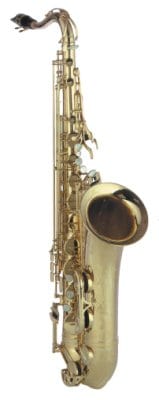Musical Instrument Review
|
REVIEWED BY JOHN ALEXANDER Recently I had the pleasure of playing two versions of the new Yamaha YAS-82Z Alto Saxophone, introduced at the NAMM show last January. One of the horns was lacquered with Yamaha's standard gold lacquer; the other one was unlacquered - that's right, just the brass and nothing else. More about this later. There are several possible options for this horn besides two finish options mentioned above.
FINISH: You can have the YAS-82Z with a gold plate finish, a silver plate finish, or with black lacquer in addition to gold lacquer and unlacquered finishes.
NECKS: Two necks are available for each finish. The G1 neck is more open. The M1 is a little tighter. According to Yamaha either a metalor hard rubber mouthpiece will work well with either neck. Each of the horns that I played came with the G1 neck. PRICE: Retail price for the gold lacquer is $3,800.00; for the unlacquered, $3,900.00; for the black lacquer and silver plate finishes, $4,000.00. I don't know about the gold plate finish. OTHER FEATURES INCLUDED:
Both Yamaha horns project well. They are a little brighter than the Mark VI, and a little bit thinner in the high register. But they are both more responsive and sound fuller in the lower register. One of the classical etudes that I played required playing sixths from the middle register across the break to the lower register (middle D to F below, for example). This was no problem at all for the Yamaha. The low F popped right out – no hang up in the throat, no hesitation in the response, no adjustment, just play it. The high register and altissimo – no problem. The altissimo notes pop right out, regardless of how loud or hard you are blowing. One cautionary note. The neck that came with each of the Yamaha horns played sharp in the upper register with my Meyer hard rubber. But with my Precision Crafted alto piece both horns played in tune. Kurt Witt, of Yamaha Corporation of America, later advised me about the difference in the necks. If you play both hard rubber and metal mouthpieces regularly you might want to get both necks, or at least try both pieces with each neck. Another "feel" thing. The pearls on the Yamaha are a little more concave that my Mark VI. Going back and forth between the two Yamaha's and the Mark VI required a moment of acclimation. Not a problem when you play the Yamaha full time. Now to the lacquered and unlacquered finishes. The lacquered finish horn sounds a little more focused but a little compressed. Lacquer equals less vibrations. The unlacquered horn resonates more fully and you can hear a little more core in the sound. I took my horn and the two Yamaha's to my repairman, Jon Mills of Music and Arts in Charlotte, NC. We spent a couple of hours playing and otherwise examining each horn, and we both came to the same conclusion. The Mark VI is a little darker, has a great core, and the upper register is a little fuller. The unlacquered Yamaha is a little brighter, the core is still there, the bare brass vibrates in a way that you can both hear and feel, and the sound is full and round. The lacquered Yamaha is slightly brighter still, and the sound is a little more focused, but it doesn't resonate like the unlacquered horn. Yamaha figures that the jazz guys will go for the unlacquered horn, and I agree with them. If I had the bread I would buy one today. It's not a Mark VI, but it's close – very close. Here's another angle — the repair and maintenance viewpoint. As I said, I took both horns to my repairman, Jon Mills, to get his take on the sound. But I also wanted his opinion on the way the horn was put together. Some of his observations include:
John Alexander, Jazz Improv © Jazz Improv®, 491 Old York Rd, Jenkintown, PA 19046 All rights reserved. Reprinted with permission e-mail: jazz@jazzimprov.com www.jazzimprov.com. For more information, write Yamaha Corporation of America, Band & Orchestral Division, P.O. Box 6600, Buena Park, CA 90620; call (714) 522-9011 or send e-mail: infostation@yamaha.com Related Link: YAS-82Z |
 |
| © 2010 Yamaha Corporation of America. All rights reserved. |

